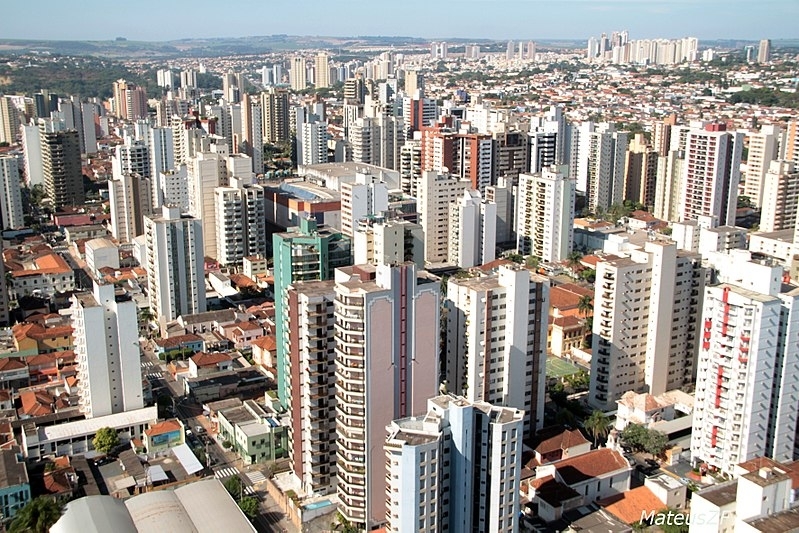

Hub cities far from state capitals can accelerate interiorization of the disease, according to a collaboration involving universities and the national disaster surveillance center (photo: aerial view of Ribeirão Preto / MateusZF , Wikimedia Commons)
Hub cities far from state capitals can accelerate interiorization of the disease, according to a collaboration involving universities and the national disaster surveillance center.
Hub cities far from state capitals can accelerate interiorization of the disease, according to a collaboration involving universities and the national disaster surveillance center.

Hub cities far from state capitals can accelerate interiorization of the disease, according to a collaboration involving universities and the national disaster surveillance center (photo: aerial view of Ribeirão Preto / MateusZF , Wikimedia Commons)
By Elton Alisson | Agência FAPESP – The potential transmissibility of COVID-19 in Brazilian cities such as Ribeirão Preto (state of São Paulo), Campina Grande (Paraíba) and Caruaru (Pernambuco) is the same as in some state capitals. All three are mid-sized cities far from the coast. As economic powerhouses with many manufacturers and service providers, they are strategically important in terms of regional mobility, with much commuting and freight hauling to and from other towns and cities.
Given the intense flows of people and vehicles, they play a key role in spreading COVID-19 into the interior of Brazil, according to a study by researchers at the Federal University of Ouro Preto (UFOP) in Minas Gerais and São Paulo State University (UNESP) in São José dos Campos, in collaboration with colleagues at Brazil’s National Disaster Surveillance and Early Warning Center (CEMADEN).
The study resulted from a Thematic Project supported by FAPESP. A report on its findings is available on medRxiv in a pre-print version that has not been peer-reviewed.
“These cities can accelerate and magnify the interiorization of COVID-19, providing a shortcut for the disease to spread to other towns with which they have links,” Leonardo Bacelar Lima Santos, a researcher at CEMADEN, told Agência FAPESP.
To identify the cities most vulnerable to transmission of the disease, the researchers analyzed mobility in the Southeast, South, Northeast and Center-West regions of Brazil using a method known as the “complex network” approach.
IBGE, the national census and statistics bureau, was the source of travel data used to construct interurban terrestrial mobility networks involving round trips between cities. The cities were network nodes and the links between them were edges (visual representations of relationships).
Mathematical tools were deployed to compute the number of towns to which a city is linked, as a means to finding the number of possible destinations for transmission of the virus, as well node strength (numbers of people traveling to and fro), and betweenness centrality, a measure of a city’s topological importance to the most probable routes for such travel.
The results showed that cities such as Campina Grande, Caruaru and Feira de Santana (in the state of Bahia) have higher node strengths than some capitals. Some cities in the state of São Paulo, such as Ribeirão Preto, Jundiaí, Sorocaba, Piracicaba and Presidente Prudente, ranked highest in all the metrics analyzed.
When the researchers correlated these results with the number of confirmed cases of COVID-19 in Brazil on May 1, they found node strength to be most closely associated with geographical transmission of the disease. Cities with high node strength were also those that first reported cases of the disease.
“Mobility is a key variable in disaster research and studies of disease transmission,” Santos said. “The people affected by a flood, for example, aren’t just the people who live in the flooded area but also those who travel to or through it to get to work.”
Santos is currently a visiting research fellow at Humboldt University, Berlin (Germany), with a scholarship from FAPESP.
Interiorization of the disease
The researchers also computed the threshold above which cities become more likely to report confirmed cases of COVID-19 or influence transmission of the disease. In March, not long after the pandemic reached Brazil, the threshold was high, meaning that cities had to have high flows of people to report cases of the disease. The threshold became lower from mid-April.
“This is a possible signature of the COVID-19 interiorization process in Brazil,” Santos said. “Cities with fewer commuters now run a significant risk of having cases because of their links with regional centers.”
The researchers plan to include air and river travel data in their analysis in order to understand the dynamics of mobility among towns and cities in the North region, especially the Amazon.
They expect the results of the study to support decisions to intervene in mobility between cities during the pandemic and in future public health emergencies.
“More epidemics are probable in future, unfortunately, so the study can serve as a resource for predicting which cities are most likely to report new cases and contribute to preventive action strategies,” Santos said.
The article “The correspondence between the structure of the terrestrial mobility network and the emergence of COVID-19 in Brazil” (doi: 10.1101/2020.05.17.20104612) by Vander L. S. Freitas, Jeferson Feitosa, Catia S. N. Sepetauskas and Leonardo B. L. Santos can be retrieved from: www.medrxiv.org/content/10.1101/2020.05.17.20104612v1.
Republish
The Agency FAPESP licenses news via Creative Commons (CC-BY-NC-ND) so that they can be republished free of charge and in a simple way by other digital or printed vehicles. Agência FAPESP must be credited as the source of the content being republished and the name of the reporter (if any) must be attributed. Using the HMTL button below allows compliance with these rules, detailed in Digital Republishing Policy FAPESP.




